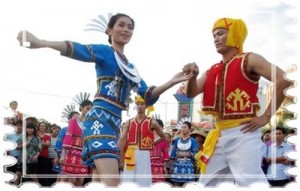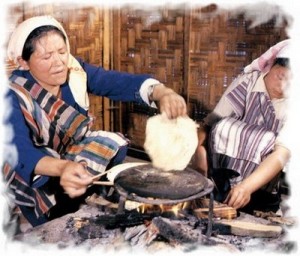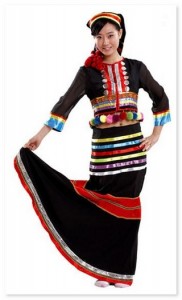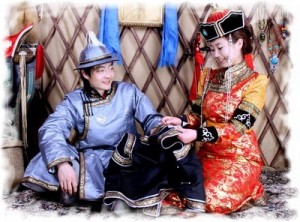Hani clothing is both the ethnic characteristics, but also has a high technology aesthetic value. Yunnan Hani clothing prime quaint, the Hani people planting hemp, cotton, indigo grass, specializes in advocating black, indigo dyeing, the Kazakh nation do with the own dyeing Navy homespun clothes. Hani different, clothing for children, young adults, elderly folk clothing three changes “saying. The previous six-year-old baby and children clothes basically no gender distinction, boys and girls are wearing from woven cloth round cap crowns pig teeth, seashells, tiger leopard claw, pangolin scales, shells and other objects, The boys usually wear black, no jewelry, girls’ clothes with some silver bubble, the color ear ornaments. Increase with age, after the age of 15, men and women have to change clothes design, will also increase the body ornaments, the men switched to black cloth scarf wrapped around the head, the woman to wear the studded silver medal bra cloth, Hani men and women dress this gorgeous accessories has been extended to marriage, birth parents, they would gradually become less bright ornaments. To 45 years after the man’s silver chain, silver bubble, removed from the clothes, ready to future generations, cylinder woman to remove the cap, hat, pectoral no longer wear, wearing a plain black blue skirt to make themselves appear to be simple and elegant, dignified.

Around the clothing styles vary, but in general, the characteristics of Hani’s clothing: men wear breasted jacket and trousers with a blue cloth or white cloth header; woman wearing right lapel collarless coat, trousers, short skirts, boots or wrinkled skirt, the majority of women wrapped leggings, dress more embroidery patterns.
Hani Men’s Clothing
Hani adult men wear loose collarless left front jacket, Sleeve and wrist and narrow, with a chic cloth button and the luminous silver coins for the buckle, inlaid colored lace clothes. Beneath the wide waist pants pants, belt sewn into a long-shaped bag, the bag was a duckbill-shaped, with red and green silk thread lock side, the back of the belt tied with a string of silver chain tied with silver coins. The old man, build a handful of hair braiding to stay in the top of the head of the customs, are now often the black cloth or white Buguo of head. Xishuangbanna man wearing a the right lapel T-shirt, along dajin inserts two lines of silver pieces for decoration. Festival, festive period, the young man accompanied by a white underwear under the cyan or blue jacket, cuffs, collar and side placed at evenly exposed a white border.
Hani Women’s Clothing
Hani women’s clothing colors, styles and patterns, can be described as colorful, and the living area there are significant differences, in general, women’s clothing exquisite workmanship, reflects the hard work and wisdom of the Hani women.
Mojiang, Yuanjiang area women, tops plus a shawl, and some wear long skirts or wrinkled dress, some wearing knee-length shorts, leggings, embroidered belt and apron. Xishuangbanna and the Lancang River in the vicinity of women wear short skirts, playing Leggings, chest hanging clusters of silver, wearing a round hat set with a small silver bubble, also has a long skirts and ruffle skirt.
More features regional and branch of women’s clothing, such as: the south bank of the Red River Sheep Street, the breakwaters along Hani (leaves car lineage). Their tops collectively referred to as the “turtle skirts, divided into three layers, namely, jackets, shirts and underwear. The coat is known as the “bird Lang, is swinging for the Indigo breasted jacket, collarless round mouth, Sleeve and elbow width on both sides of the cardigan pinned a number of sophisticated decor breasted. “Bird Long” dip into the Indigo, coated with a light layer of leather glue to its micro Pan pink, expressed craft high strength. Shirt called “bird bar”, no collar, pointed mouth, hem round tortoise-like, about two lapel cut slightly wider, ride in front, and fine cotton thread the left lapel system in the right armpit, cross into scissors mouth like, underwear called “bird Pa actual personal breasted coat, no buckle, no collar, round mouth, in round mouth the right front trimmed with a string of silver chain, with the Department of the needle cylinder and port string tube. Car leaves women more than clothing pride in the “bird Pa is placed under the nail several Road, cyan and white false edges, which means that more than clothing. The girl’s left chest cover tightly, right chest is half-bare. It leaves car girls youth fitness. During the festival, girls waist tight beam width if the palm of a five-color “Paa” It not only makes the girl body curve is very beautiful, and showed the sort of women was very hot British Gas. Them, wearing tight shorts wearing a steeple the triangle Toupa – and “Pa often.
Hani is a national prevalence of silver ornaments, buttons, earrings, necklaces and bracelets, or a variety of pectoral, are silver. Dance, body silver will be issued the rhythm crisp sound “Ding Ling, skirts, ring shoulder, cuffs, trouser legs, apron, belts and other clothing, multi-the mosaic color lace and embroidery patterns.












